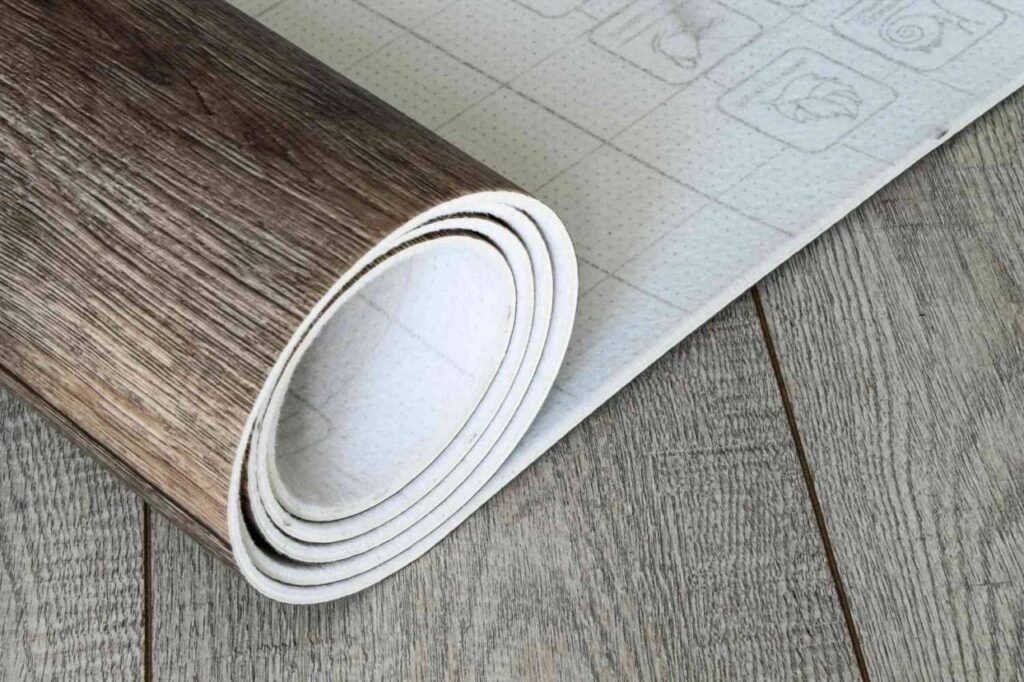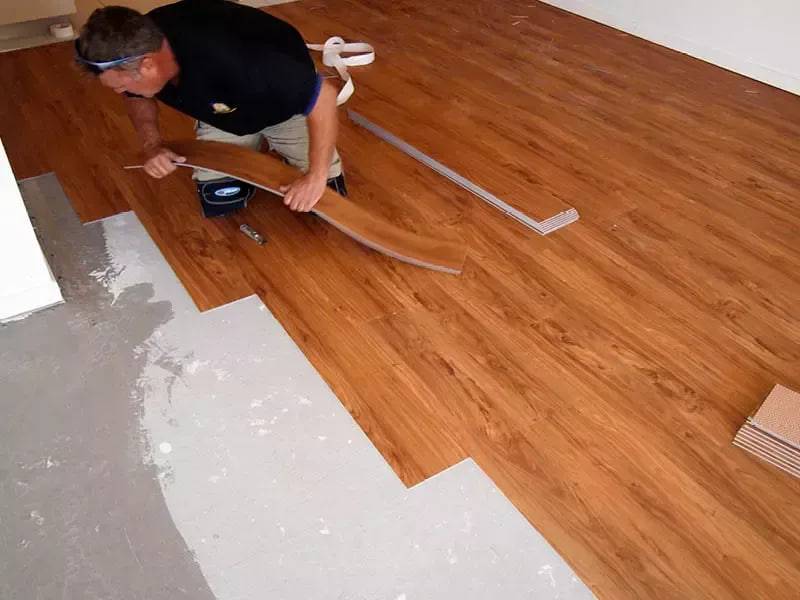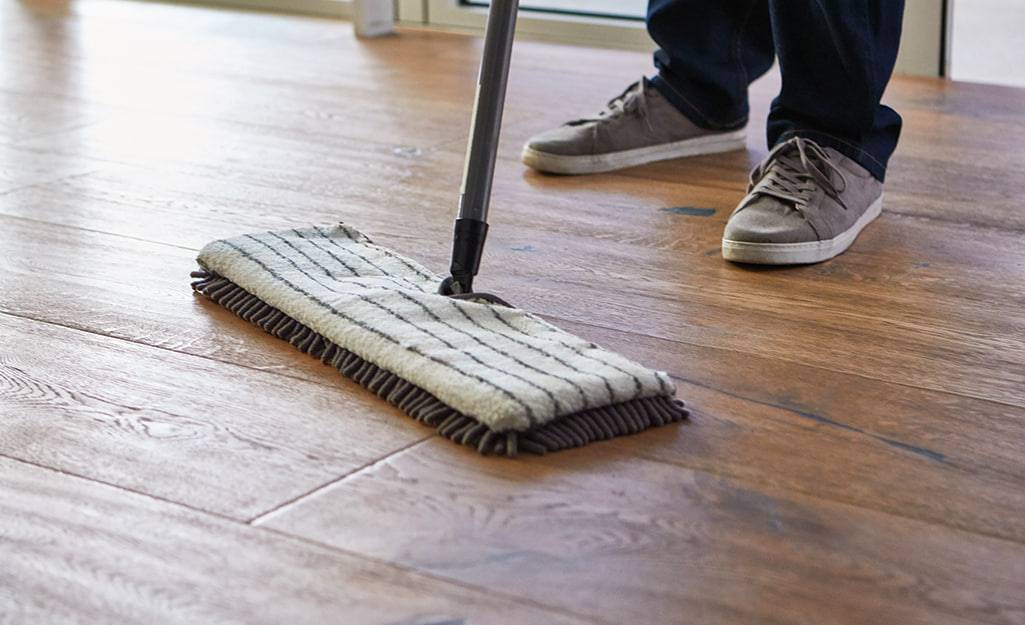In the realm of flooring, loose lay vinyl flooring has emerged as a game-changer, offering homeowners a convenient, DIY-friendly alternative to traditional flooring options.
Unlike its click-lock counterparts, loose lay vinyl planks rely on their own weight and a textured backing to remain in place, eliminating the need for adhesives or specialized installation tools. This simplicity makes it a popular choice for homeowners seeking a hassle-free flooring transformation.
Loose lay vinyl flooring boasts a remarkable array of benefits, making it an appealing choice for various applications. Its waterproof nature renders it impervious to spills and moisture, making it ideal for high-traffic areas prone to accidents. Additionally, its durability ensures resilience against heavy foot traffic and everyday wear and tear.
Furthermore, loose lay vinyl flooring offers a wide range of aesthetic options, catering to diverse tastes and preferences. From mimicking the natural beauty of wood grains to replicating the elegance of marble tiles, loose lay vinyl planks provide an unparalleled flexibility in creating stylish and visually appealing floors.
With its ease of installation, versatility, and durability, loose lay vinyl flooring stands as a testament to the evolution of DIY flooring solutions.
Its ability to transform any room without the hassle of professional installation or the expense of complex materials makes it a popular choice for homeowners across the globe.
Ready to embark on your DIY flooring adventure? Embark on a journey of discovery and explore the captivating world of loose lay vinyl flooring. Embrace the ease, versatility, and durability that this innovative flooring solution has to offer, and transform your living spaces into havens of style and functionality.
Benefits of Loose Lay Vinyl Flooring
-
Easy Installation
Loose lay vinyl flooring is remarkably simple to install, even for those with no prior flooring experience. Unlike traditional vinyl planks that require adhesives or click-lock systems, loose lay planks interlock and self-adhere due to their textured backing. This eliminates the need for specialized tools or professional installation, making it a highly DIY-friendly option.
-
Portable and Removable
One of the most attractive features of loose lay vinyl flooring is its portability. Unlike other flooring options that are permanently affixed to the subfloor, loose lay planks can be easily removed and reinstalled in another location. This makes it an ideal choice for renters or homeowners who frequently move or want to refresh their flooring without the hassle of tearing up the old surface.
-
Moisture Resistance
Loose lay vinyl flooring is exceptionally water-resistant, making it ideal for high-traffic areas prone to spills and moisture. The waterproof membrane in these planks prevents water from seeping through, protecting your flooring from damage and ensuring long-lasting durability.
-
Durability and Resilience
Loose lay flooring is known for its exceptional durability, making it a long-lasting and resilient choice for various applications. Its scratch-resistant and stain-resistant properties ensure that your flooring can withstand the rigors of everyday use.
-
Comfort and Sound Absorption
Vinyl flooring provides a comfortable and cushioned underfoot feel, making it a great choice for those seeking a softer alternative to hard flooring options. Additionally, its thick backing acts as a soundproofing barrier, reducing noise and creating a more tranquil living environment.
-
Wide Range of Designs and Styles
This type of vinyl flooring offers an extensive selection of designs and styles, catering to diverse tastes and preferences. From replicating the natural beauty of wood grains to emulating the elegance of marble tiles, these planks provide a vast array of options to transform any room in your home.
-
Affordable and Cost-Effective
Compared to other flooring options, loose lay vinyl flooring is generally more affordable and cost-effective. The ease of installation and the longevity of the flooring contribute to its overall affordability.
-
Low Maintenance and Easy Cleaning
Loose lay vinyl flooring requires minimal maintenance and is easy to clean. Sweeping, vacuuming, and occasional mopping are sufficient to keep your flooring looking its best. The waterproof nature of these planks further simplifies cleaning, as spills can be easily wiped up without causing damage.
-
Environmentally Friendly
Some loose lay vinyl flooring options are made with recycled materials and feature sustainable manufacturing processes. These eco-friendly options contribute to a more environmentally conscious choice for your flooring.
-
Versatile Application
Loose lay vinyl flooring can be used in a variety of rooms throughout your home, including living rooms, bedrooms, kitchens, bathrooms, basements, and even outdoor patios. Its versatility makes it a suitable choice for both residential and commercial spaces.
Installation Process of loose lay vinyl flooring
Step 1: Preparation
- Remove existing flooring: Before installing loose lay vinyl flooring, remove any existing flooring, such as carpet, laminate, or tile.
- Inspect the subfloor: Ensure the subfloor is clean, dry, and free of any imperfections that could affect the installation of the loose lay vinyl planks. Patch any cracks or holes with patching compound.
- Level the subfloor: If the subfloor is uneven, use leveling compound to create a smooth and level surface. Let the leveling compound dry completely before proceeding to the next step.
Step 2: Planning and Measuring
- Determine the layout: Decide on the layout of the loose lay vinyl planks. You can choose a staggered layout or a straight layout.
- Measure the room: Measure the length and width of the room to determine the amount of flooring needed. Add 10% extra to allow for waste and movement.
- Mark the starting point: Use a chalk line or straightedge to mark the starting point for the first row of planks. Ensure the starting point is aligned with an existing wall or doorjamb.
Step 3: Installing the Loose Lay Vinyl Planks
- Unroll the loose lay vinyl planks: Carefully unroll the loose lay vinyl planks, spreading them out in the room to acclimate to the temperature and humidity for at least 24 hours.
- Start laying the planks: Beginning at the marked starting point, carefully lay the loose lay vinyl planks next to each other, ensuring they interlock properly. Use a tapping block or roller to secure the planks and eliminate any air bubbles.
- Cut the planks: Use a utility knife or a guillotine to cut the planks to fit around obstacles, such as door openings and pipes.
- Install the edge rows: For the first and last rows of planks, use double-sided tape along the perimeter of the room to secure them.
- Seal the seams: Apply a seam sealant along the seams between the planks to prevent moisture from seeping in.
Step 4: Finishing Touches
- Remove excess tape: Carefully remove any excess double-sided tape from the edges of the planks.
- Roll out a protective mat: If desired, roll out a protective mat over the loose lay vinyl flooring to add an extra layer of protection and comfort.
- Enjoy your new flooring: Admire your newly installed loose lay vinyl flooring and enjoy the stylish and durable surface.
Loose Lay Vinyl Floors Maintenance & Cleaning
Maintenance
Loose lay vinyl flooring is remarkably low-maintenance, requiring minimal effort to keep it looking its best. Here are some simple maintenance tips to ensure your loose lay vinyl flooring remains in pristine condition:
- Sweep or vacuum regularly: Daily sweeping or vacuuming removes dirt and debris, preventing them from accumulating and scratching the flooring.
- Wipe up spills immediately: Promptly wipe up spills with a soft, damp cloth. Avoid using harsh chemicals or abrasive cleaners, as these can damage the finish of the flooring.
- Avoid heavy furniture: Placing heavy furniture directly on loose lay vinyl planks can cause indentations or damage to the planks. Use felt furniture pads or protective mats to distribute weight evenly.
- Avoid dragging furniture: Dragging furniture across the floor can scratch or damage the surface. Lift furniture when moving it to avoid unnecessary wear and tear.
- Protect from direct sunlight: Prolonged exposure to direct sunlight can fade or discolor loose lay vinyl flooring. Use blinds, curtains, or shades to minimize direct sunlight exposure.
Cleaning
Regular cleaning is essential to maintain the appearance and longevity of your loose lay vinyl flooring. Here’s a step-by-step guide for cleaning your loose lay vinyl flooring:
- Prepare the cleaning solution: Dilute a mild detergent in warm water. Avoid using harsh chemicals or abrasive cleaners, as these can damage the finish of the flooring.
- Mop the floor: Dampen a mop with the cleaning solution and wring it out well. Mop the floor in a straight line, avoiding excessive scrubbing or twisting.
- Rinse the mop: Rinse the mop frequently to prevent streaks and dripping.
- Wipe up excess water: Use a clean, dry microfiber cloth to wipe up any excess water that may have accumulated on the floor.
- Let the floor air dry: Allow the floor to air dry completely before exposing it to foot traffic.
For stubborn stains, you can use a soft-bristled brush dipped in the cleaning solution. However, be gentle and avoid excessive scrubbing to prevent scratching the finish.
Regular maintenance and proper cleaning will ensure your loose lay vinyl flooring remains beautiful and functional for years to come.
Summary
Loose lay vinyl flooring is a popular choice for homeowners due to its ease of installation, versatility, durability, and low maintenance. It is a water-resistant, scratch-resistant, and stain-resistant flooring option that can be used in a variety of rooms, including living rooms, bedrooms, kitchens, bathrooms, basements, and even outdoor patios. The installation process is straightforward and can be done by most homeowners without the need for professional assistance. Loose lay vinyl flooring requires minimal maintenance, and regular cleaning with a mild detergent and water will keep it looking its best for years to come.
FAQs
Q: What is loose lay vinyl flooring?
Loose lay vinyl flooring is a type of flooring that can be installed easily and quickly without the need for adhesives. The planks are interlocking and self-adhering, so they simply snap together and stay in place. Loose lay vinyl flooring is made from PVC, which is a durable and water-resistant material. It is also scratch-resistant and stain-resistant, making it a good choice for high-traffic areas.
Q: What are the benefits of loose lay vinyl flooring?
- Easy to install: Loose lay vinyl flooring is one of the easiest types of flooring to install. There is no need for adhesives or special tools, so it can be done by most homeowners without professional help.
- Portable: Loose lay vinyl flooring can be easily removed and reinstalled in another location. This makes it a good choice for renters or homeowners who frequently move.
- Water-resistant: Loose lay vinyl flooring is made from a waterproof material, so it is a good choice for kitchens, bathrooms, and other areas prone to moisture.
- Durable: Loose lay vinyl flooring is a durable material that can withstand heavy traffic and everyday wear and tear.
- Scratch-resistant: Loose lay vinyl flooring is scratch-resistant and stain-resistant, so it can maintain its appearance for years.
- Low-maintenance: Loose lay vinyl flooring is low-maintenance and requires minimal cleaning. Simply sweep or vacuum it regularly and wipe up spills with a damp cloth.
Q: What is the installation process for loose lay vinyl flooring?
The installation process for loose lay vinyl flooring is relatively simple. Here are the basic steps:
- Remove the old flooring: If there is existing flooring in the room, remove it and make sure the subfloor is clean and level.
- Lay out the planks: Unroll the planks and lay them out in a straight line, ensuring they interlock properly.
- Secure the planks: Use a tapping block or roller to secure the planks in place and eliminate any air bubbles.
- Trim the planks: Cut the planks to fit around obstacles, such as door openings and pipes.
- Seal the seams: Apply a seam sealant along the seams between the planks to prevent moisture from seeping in.
- Finishing touches: Remove any excess tape and roll out a protective mat (optional).
Q: How do I clean loose lay vinyl flooring?
Loose lay vinyl flooring is very easy to clean. Simply sweep or vacuum it regularly and wipe up spills with a damp cloth. For stubborn stains, you can use a mild detergent and water. Avoid using harsh chemicals or abrasive cleaners, as these can damage the finish of the flooring.
Q: What are some of the drawbacks of loose lay vinyl flooring?
- Not suitable for all surfaces: Loose lay vinyl flooring is not suitable for all types of subfloors. The subfloor must be clean, dry, and level, without any significant bumps or cracks.
- Can be susceptible to curling: If the subfloor is not properly prepared, the loose lay vinyl planks may curl over time.
- Limited warranty: Loose lay vinyl flooring typically comes with a limited warranty, so it is important to read the warranty carefully before purchasing.
Q: Is loose lay vinyl flooring a good investment?
Loose lay vinyl flooring can be a good investment for homeowners who are looking for a durable and easy-to-maintain flooring option. It is a relatively affordable option, and the low maintenance requirements can save you money in the long run.
Q: What are some tips for choosing loose lay vinyl flooring?
- Consider the style of your home: Loose lay vinyl flooring comes in a wide variety of styles to match any decor.
- Choose a durable and water-resistant grade: Loose lay vinyl flooring is available in different grades. Choose a grade that is suitable for the traffic in your home.
- Read the warranty carefully: Most loose lay vinyl flooring comes with a warranty, so it is important to read the terms and conditions carefully before purchasing.
- Purchase from a reputable retailer: Buy your loose lay vinyl flooring from a reputable retailer to ensure you are getting high-quality product.



